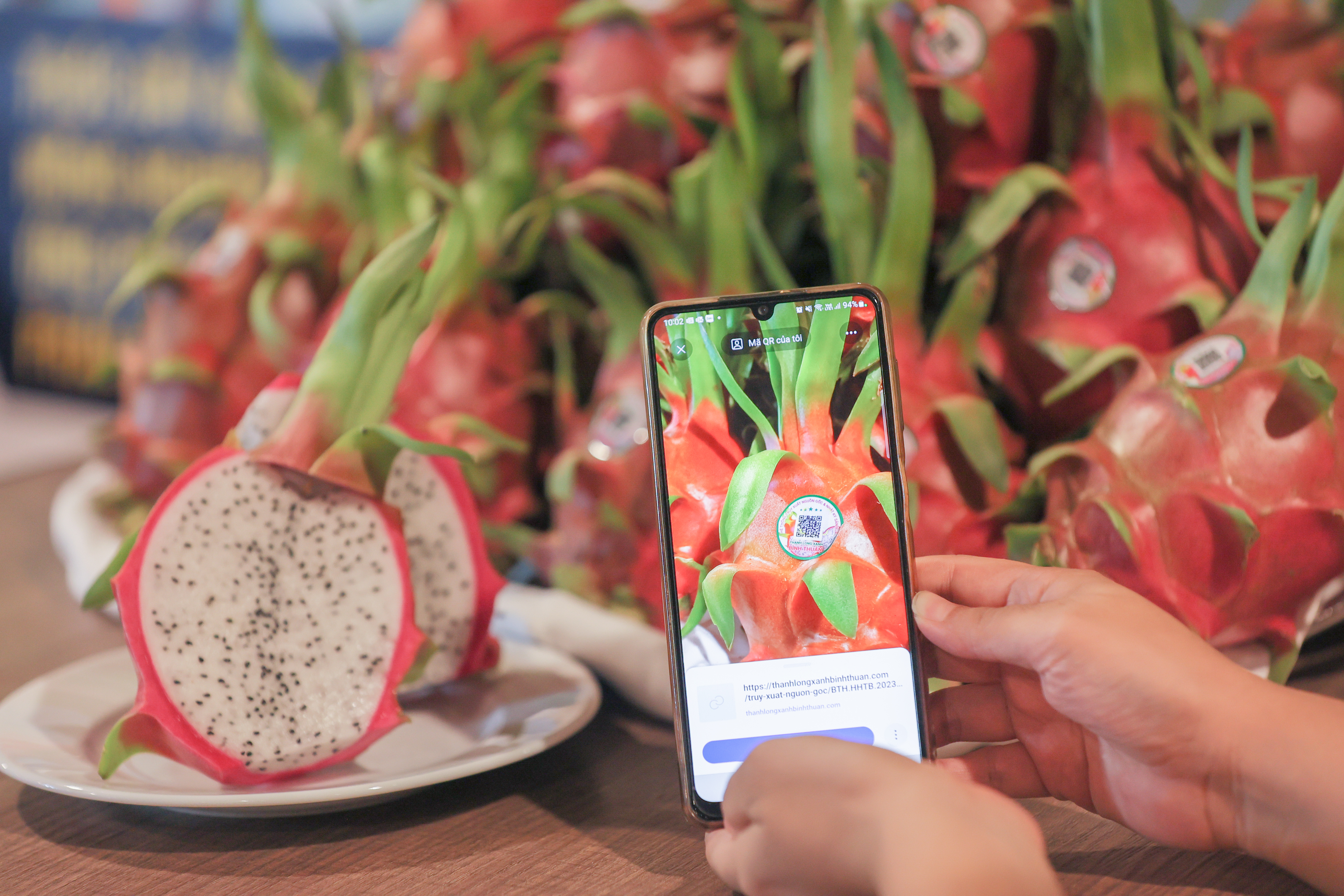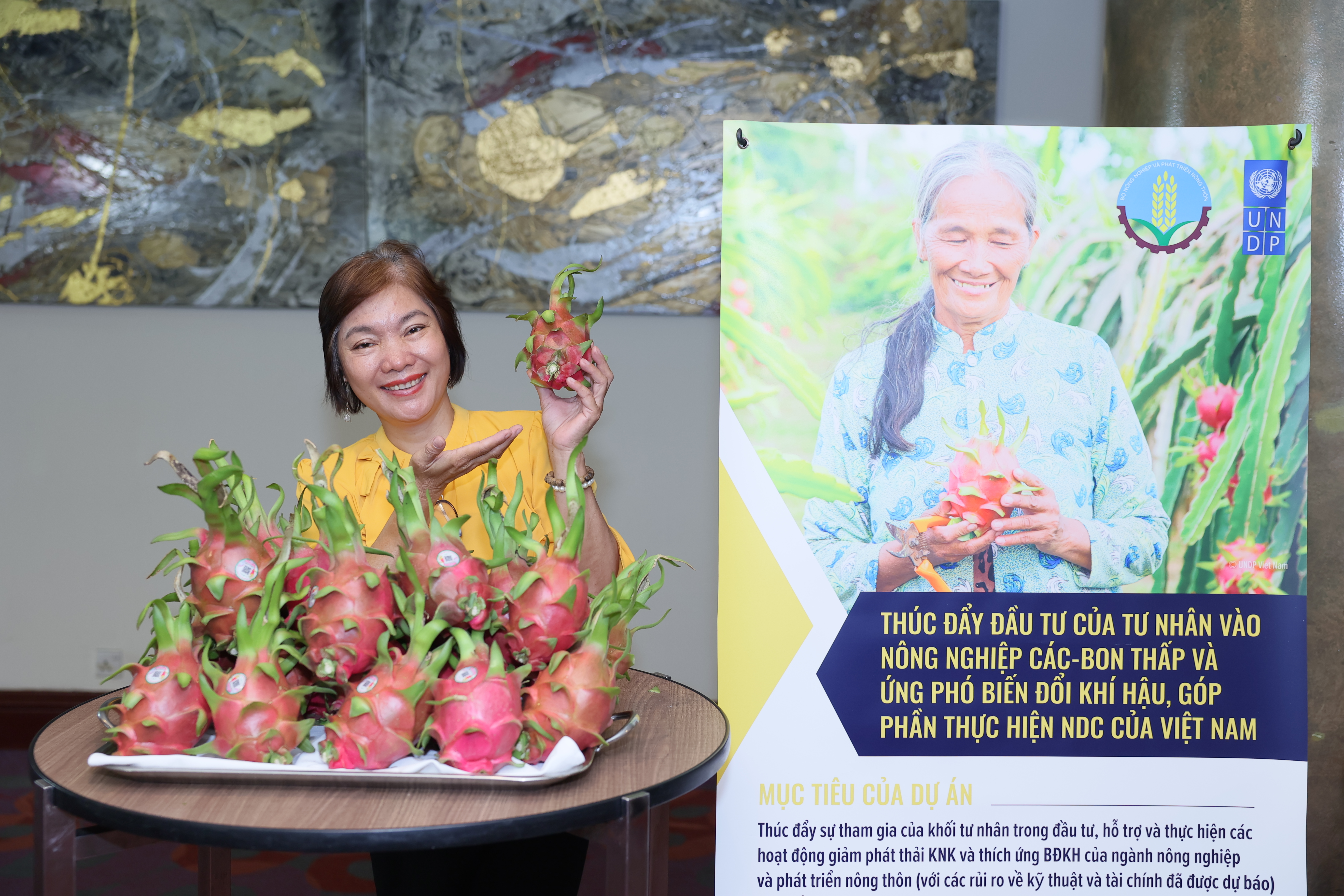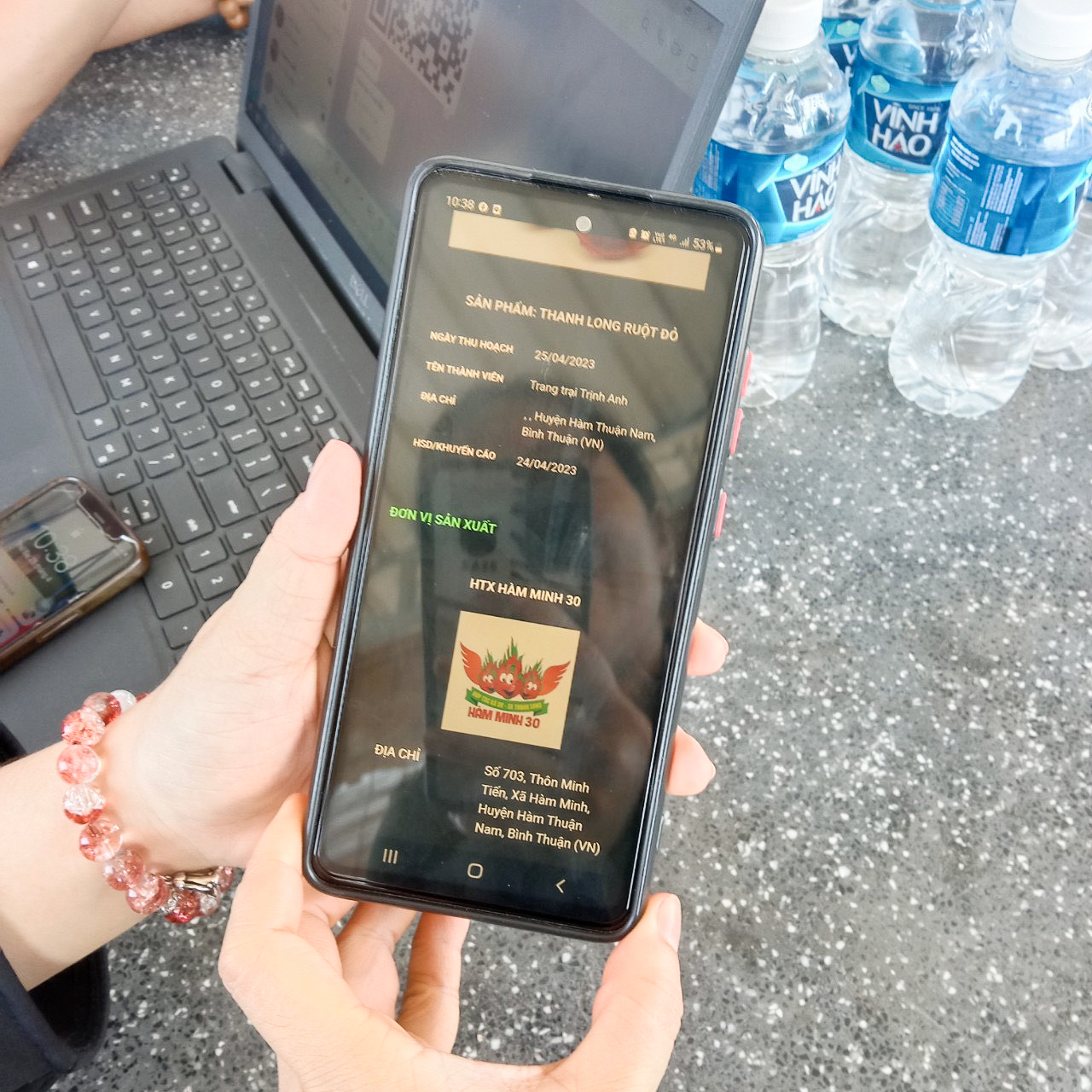An article written by Linh Le (UNDP Viet Nam) and Phuong Dung
E-Traceability: A transformative step towards climate-responsible agriculture
August 17, 2023

‘E-identity’ of Vietnamese agricultural products
Recently, Vietnamese agricultural products in supermarkets and local stores nationwide with a QR code stuck on them. With just a quick scan from a smartphone, consumers can directly access information related to the source, production unit code, and the growing and transporting processes of each product.

Scanning the QR code to trace the agricultural products’ origin
Currently, there are several commodity lines on the market with QR codes, including vegetables (Lam Dong), mangos (Dong Thap), durian (Dak Lak), etc.
The QR code is considered as providing a form of ‘identity’ for agricultural products, enhancing customers’ confidence, and ensuring the responsibility of manufacturers and suppliers with products’ quality sold at market.
Moreover, this is a crucial transforming step to bring Vietnamese agricultural products closer to the enormous and fastidious foreign markets such as the U.S., China and Europe, in the rise of strict importing laws.
QR codes tracing dragon fruit origins
Providing QR codes to trace the products’ origin has been piloted for Binh Thuan dragon fruit since February 2023 in 300 farms (178 ha). To collect diverse and inclusive data for later analysis, the selected farming methods must spread across VietGAP, GlobalGAP, Organic and Conventional production practices.
In addition to identifying information, the QR codes on the dragon fruit products participating in the pilot program also include data on the amount of greenhouse gases (GHG) emitted into the environment during the entire production and distribution process - also known as a ‘Carbon footprint’.

QR code on Binh Thuan dragon fruit product
The pilot program is a core activity of the 3-year roadmap of “greening” dragon fruit, in collaboration with MARD, UNDP Viet Nam and Binh Thuan province, as part of the project “Accelerating private sector engagement in climate resilient and low emission investment opportunities in Viet Nam's NDC.” With financial support from the Governments of Germany, Spain and the European Union, the project aims to actively encourage private sector engagement to finance, support, and implement technically sound, financially viable, risk-informed mitigation and adaptation action in support of Viet Nam’s emerging NDC targets.

Binh Thuan farmers are updating production data to the tracking application
Since starting the pilot program, the workload of Mr Le Van Kha (Hoa Le cooperative) has increased significantly.
Not only monitoring production processes and business situations, but Mr Kha also has to spend time updating detailed information about the amount of water, fertiliser and energy (electricity, oil, etc.) used at each stage (seeding, flowering, harvesting, etc.).
This data will be analysed by a calculation tool provided by the project’s experts, so Mr Kha can easily track the emissions of his family’s farm by season, planting area, or per kilogram of dragon fruit, before selling on the market.
“Recently, I signed a contract with a company to export a massive amount of dragon fruit from my farm to Europe,” Mr Kha shared. “The director visited my farm in person and was satisfied with the process of monitoring emissions as well as the climate-friendly cultivating methods applied on my dragon fruit farm (GlobalGAP standard). Therefore, I would love to continue the carbon footprint tracking system that UNDP is helping to implement in Binh Thuan in the future. It has brought positive signals for our business after a long time affected by Covid-19.”
Not only Mr Kha, but Mrs Chi (Ham Minh 30 cooperative) also affirm the advantages of the e-traceability system to dragon fruit production, but see it as an improvement on the traditional hand-written tracking method and increases the transparency of each product being sold to consumers. According to her, by disclosing the production logs as well as information about carbon emissions in the entire production process, producers like her will be more responsible for the product’s quality and customers’ health.
Initial results
The initial assessment of the carbon footprint of dragon fruit in Binh Thuan for different farming systems based on about 100 interviews indicates a lower carbon footprint for GlobalGAP, organic and VietGAP compared to that of traditional farming.
In all farming practices, the majority of GHG emissions are associated with fertiliser application (42-52% of total emissions), followed by electric power (26-42%), petrol and diesel (14-21%).
The opportunity for reducing emissions from dragon fruit production should focus on improving the efficiency of using fertilisers and electric power. Additionally, planting woody trees in open areas such as the buffer and/or farm boundary can potentially reduce emissions from dragon fruit production and the supply chain.
Furthermore, the carbon footprint calculation tool contributes to forecasting the output and harvesting date for each farming household. According to Dr Vu Tan Phuong, Director of Viet Nam Forest Certification Office, this helps farmers be more active in their business plans.
Moreover, the initial results and lessons learnt from the dragon fruit pilot program will be continuously analysed to improve the process and, in the future, will be applied to the shrimp supply chain in Bac Lieu province.

Recommendations on carbon footprint reduction for Binh Thuan dragon fruit supply chains
Traceability towards sustainable and climate-responsible agriculture
Understanding the sources and level of GHG emissions could be a game changer for Vietnamese farmers and consumers, leading to a shift in farming practices use of energy, water and fertiliser towards more sustainable and climate-responsible agriculture.
“For the first time, Viet Nam has established an innovative e-traceability system to track the origin and carbon footprints of each dragon fruit produced in the major export region like Binh Thuan. In the context of green transition in agriculture, this is an important tool for local producers and businesses in Viet Nam to track and manage the GHG emission level of the supply chain and avoid unnecessary restrictions to export to the high-end markets, where carbon border adjustment mechanism is on the rise,” said Ms Ramla Khalidi, UNDP Viet Nam Resident Representative.
Furthermore, digital solutions for growing area management, traceability and carbon footprint tracking can help small farming households, cooperatives and small and medium-sized enterprises producing clean and green products to have more of an equal ‘voice’ in the market. It means a higher profit, a bigger group of consumers and more valuable production chains. The QR codes provide the link between sustainable production and responsible consumption needed for a climate-responsible future.
In order to achieve that ambition, green finance solutions should be enhanced. Starting from a single supply chain and then spreading to the rest of Vietnamese agriculture, to create a foundation of a transparent and fair market; and bring more benefits to farmers participating in the green and digital transformation. Both the short and long-term benefits will motivate farmers to engage in developing sustainable and low-emission agriculture in Viet Nam.

 Locations
Locations



